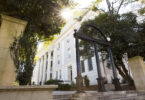Athens, Ga. – High in the cloud forests of Ecuador, Georgia public school teachers listened and waited. Toucans, trogans and numerous species of hummingbirds flew through the canopy. In the damp, cool landscape, orchids and other plants filled the air with rich scents.
Welcome to a summer field course that from June 27-July 6 attracted some 20 teachers from all over the state to lush sites in this South American country. Each day was packed with intensive study of issues relating to sustainable development. The course was sponsored by the Georgia Museum of Natural History, part of the University of Georgia’s Franklin College of Arts and Sciences, and the State Botanical Garden of Georgia.
The field school was based in the Maquipucuna Reserve, which has around 15,000 acres of primary and secondary forest and is located within Ecuador’s Choco Andean Bioregion, one of the world’s top-five biodiversity hot spots. The reserve incorporates habitats ranging from 4,000 to 9,000 feet above sea level.
“The reserve really has everything a field school like this needs,” said Carol Hoffman, education director of the museum and co-leader of the field school. “It’s a fascinating biological and ecological site, and a wonderful place to take teachers.”
Co-leader Anne Shenk, director of education at the Botanical Garden, agrees.
“The extent of the area’s biodiversity is evident everywhere,” she said. “For instance, every time you turn over a leaf you find an insect.”
But the beautiful cloud forest supports much more than insects and birds. Jaguars and spectacled bears prowl the reserve, too. And despite the fact that it’s almost directly on the equator, its altitude (some 4,000 feet) gives it a cool, wet climate.
The course, called The Global Naturalists Learning Community: Tropical Ecology of the Andes, developed from previous work that Hoffman and Shenk did with the Maquipucuna Foundation, including an international education project called “Our Shared Forests.” They designed the new field school and activities that teachers will take back to their classrooms to enhance scientific inquiry and help their students understand that global environmental issues affect them in Georgia.
“Once when I was sharing my travel experiences with a group of students, I said that I enjoyed learning about other places and sharing it with them,” said Halley Page, a teacher at Fowler Drive Elementary School in Athens-Clarke County. “One of the students said, ‘And that’s how we get to go, too!’ Educators that have this type of experience increase their knowledge base and pass on their renewed excitement to their students. I hope it will inspire their students to someday see the world and appreciate the diversity of cultures and environments that exist.”
The sheer richness of biodiversity in the Reserve is enough to startle anyone. Maquipucuna is home to a great variety of species, many of them endangered and/or endemic. There are around 2,000 plant species (more than 200 species of orchids), more than 349 bird species and more than 50 species of mammals.
“In addition to gaining a deeper understanding of the effects of a variety of land uses on the environment, course activities helped teachers gain a greater understanding of their students with family origins in Latin America,” explained Shenk.
Hoffman said the teachers also visited several towns and saw how homes, markets, schools, businesses and micro-enterprises operate and how they fit in with goals of sustainability. For instance, the town of Salinas has some 93 micro-enterprises, including chocolate and cheese production.
“Because of hunting and development pressures, some of the original species are gone, but so much remains, and there’s so much richness and diversity, that saving it is important, and every teacher understood that,” she said.
That perspective was tested often, however, not least on one trip when a giant cockroach made its appearance, along with numerous species of spiders and scorpions.
The group studying at the field school this summer included high school science teachers, middle school life- and earth-sciences teachers and upper-elementary science specialists. Each had to write a preliminary essay on why she or he wanted to attend the field school, and the group’s eagerness and eloquence assured Hoffman and Shenk of an interested and committed trip. Each teacher earned seven Professional Learning Units-extended education that all teachers in Georgia must earn during their careers.
“The trip to Ecuador provided me with a comprehensive perspective of the interdependence of all people on the environment, exposing me to the diversity of cultures within one nation, and showing me the dependence on resources available within the different climate zones within the country,” said Steven King of Whit Davis Elementary School, also in Athens-Clarke County. “The experiences of this trip will shape my instruction to my students in the areas of biology, environmental science, sociology, geology and climatology. It will always be a trip that I will never forget.”
Those attending included Page and King of Athens-Clarke Co.; Vickie Peace from Rome High School; Kim Bird from Forest Park High School; Maureen Tompkins from Flat Rock Middle School in Tyrone; Dawn Richards from Chestatee Middle School in Gainesville; Jennifer McCoy from Cobb County Water Education Program in Cobb County; Sheryl Ashley-Serafine from Nicholson Elementary School in Marietta; Korri Ellis from Henry Grady High School in Atlanta; Heather Mebs from the Oatland Island Education Center; Laurie Crooks from Stone Mountain Elementary; Naomi Thompson from Stone Mountain Park; Karen Lucas from Burroughs-Molette Elementary in Brunswick; Wendy Roberts from Sequoyah High School in Canton; Tara Thieme from Pine Mountain Middle School in Kennesaw; Kristen Roberts from Shamrock Middle School in Decatur; Paula Chambers from Southwest Georgia Youth Science and Technology Center in Bainbridge; Brenda Priest from Sequoyah High School in Canton; Tracey Rivers from Holt Elementary School in Gwinnett County; and Kelly Tompkins from Loganville High School.
The field course was funded by a grant from the U.S. Teacher Quality Higher Education Program for the Improvement of Math and Science Education.







